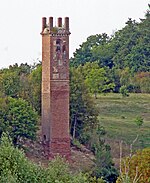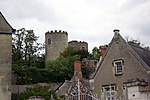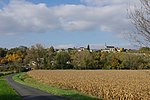Mask of la Roche-Cotard

The Mask of la Roche-Cotard, also known as the "Mousterian Protofigurine", is an artifact dated to around 75,000 years ago, in the Mousterian period. It was found in 1975 in the entrance of a cave named La Roche-Cotard, territory of the commune of Langeais (Indre-et-Loire), on the banks of the river Loire. The artifact, possibly created by Neanderthal humans, is a piece of flat flint that has been shaped in a way that seems to resemble the upper part of a face. A piece of bone pushed through a hole in the stone has been interpreted as a representation of eyes. Paul Bahn has suggested this "mask" is "highly inconvenient", as "It makes a nonsense of the view that clueless Neanderthals could only copy their cultural superiors the Cro-Magnons". Though this may represent an example of artistic expression in Neanderthal humans, some archaeologists question whether the artifact represents a face, and some suggest that it may be practical rather than artistic. In 2023 the oldest known Neanderthal engravings were found in La Roche-Cotard cave which have been dated to more than 57,000 years ago.
Excerpt from the Wikipedia article Mask of la Roche-Cotard (License: CC BY-SA 3.0, Authors, Images).Mask of la Roche-Cotard
Chinon
Geographical coordinates (GPS) Address Nearby Places Show on map
Geographical coordinates (GPS)
| Latitude | Longitude |
|---|---|
| N 47.336666666667 ° | E 0.42611111111111 ° |
Address
37130 Chinon (Langeais)
Centre-Val de Loire, France
Open on Google Maps









